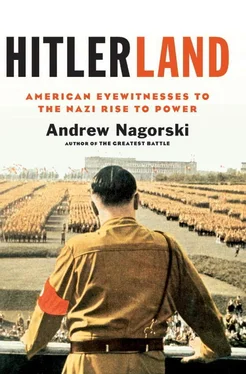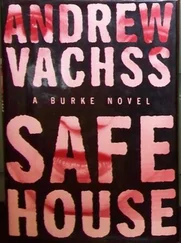During the night, the doctor explained to Helen that they, too, had tried to flee to Austria, but their car had broken down. When the driver couldn’t fix it, Hitler had suggested going to Hanfstaengl’s house since they could reach it by foot, although it was a long, difficult walk for the three worn-out men. What that story didn’t explain was how Hitler imagined he could stay hidden in the house of one of his well-known followers.
The next morning, Hitler sent off the doctor to Munich to see if he could arrange for another car to pick him up and still get him to Austria. His arm was in a sling and he appeared to be in less pain than the previous evening, but he was pacing nervously about in a blue bathrobe, asking where the car might be. Helen’s mother-in-law called to say that the police were already in her nearby house. Suddenly, an official cut her off and took the phone himself, telling Helen that he and his men would be arriving at her house next.
Helen went upstairs to let Hitler know that he was about to be arrested. Standing in the hallway, he looked devastated by the news. “Now all is lost—no use going on!” he exclaimed, throwing up his hands. Then, with a quick motion, he picked up his revolver from the cabinet. “But I was alert, grasped his arm and took the weapon away from him,” Helen recalled.
Alarmed that he might have shot himself, she shouted: “What do you think you’re doing? After all, are you going to leave all the people that you’ve gotten interested in your idea of saving the country and you take your life… They’re looking for you to carry on.”
Hitler hadn’t resisted when she grabbed the gun, and he sank into a chair, burying his head in his hands. While he was still sitting like that, Helen quickly took the gun away to dispose of it, settling on a large flour bin where it easily vanished from sight as she pushed it down deep inside. Returning to Hitler, she urged him to dictate to her all his instructions for his followers before the police arrived; that way, they would know what to do while he would be in prison. She added that he could then sign each sheet containing instructions and she would make sure they would be delivered to his lawyer. “He thanked me for helping him remember his duty to his men, and then dictated the orders which were to be of such importance in carrying on the work,” she recalled.
Soon, the police with guard dogs surrounded the house. Helen answered the knock at the door, and a shy young army lieutenant, accompanied by two policemen, apologetically explained that he had to search the house. Helen told them to follow her upstairs and she opened the door to the room where Hitler was standing. Startled, the three men took a step back for a moment. The Nazi leader had regained his confidence and immediately began berating the lieutenant in a loud voice, particularly when he told him he had to arrest him for high treason.
There was no use arguing, however, and even Hitler realized that. Refusing Helen’s offer of Putzi’s clothes to shield him from the cold, he was still dressed in the blue bathrobe, with his own coat draped over his shoulders, as the men led him down the stairs. At that moment, little Egon ran out, calling, “What are the bad, bad men doing to my Uncle Dolf?” Looking moved, Hitler patted Egon on the cheek. Then he shook hands with Helen and the maids before going out the door. Helen caught a last glance at his face when he was seated in the police car. It was “deathly pale,” she remembered.
Most of the press coverage that followed, at home and abroad, quickly wrote off Hitler and the Nazis. The Beer Hall Putsch had been laughably amateurish, and now all that awaited the arrested leaders was a trial and certain convictions.
Few people realized then that the trial and even imprisonment would serve Hitler surprisingly well. And only a few insiders knew then that it was a young American woman, the wife of one of his earliest followers, who may have prevented him from taking his own life—an act that would have delivered humanity from the devastating consequences of his political resurrection later. It was Helen Hanfstaengl, née Niemeyer, who, in the worst possible way, may have changed the course of history.
Like Knickerbocker who quickly became a close friend, Edgar Ansel Mowrer of the Chicago Daily News was a new arrival in Berlin in 1923, showing up late that year and staying for a decade, right through Hitler’s rise to power. And, like Knickerbocker, Wiegand and other correspondents, he was as much intrigued by the German capital’s dynamism in the arts as by its chaotic politics. The city was “a cultural riot, the wilder for the lack of such deep traditions as still had held sway in Paris and London,” he recalled. Along with his British-born wife Lilian, he was quickly swept up in that cultural riot.
At the annual Press Ball in the huge Zoo Restaurant, the Mowrers had the chance to mingle with everyone from top government officials and the high-society crowd to the playwrights Bertolt Brecht and Carl Zuckmayer, composer Richard Strauss when he was visiting from Vienna to conduct an opera, and conductor Wilhelm Furtwängler. The event brought together “the leaders of totally different worlds,” Mowrer wrote. “It was as though Paris had merged the Elysée, the Opéra, and the Beaux Arts Ball into one vast get-together that opened with the dignity of a state reception and ended in a bacchanal.”
Initially, Lilian Mowrer had been distinctly unimpressed with Berlin when she followed her husband after wrapping up the couple’s affairs in Rome, their previous assignment. Arriving in March 1924, she was depressed by the figurative and literal cold and the contrast to Italy, where spring flowers were already in bloom. “In Berlin ice still covered the ponds in the Tiergarten, and the atmosphere was leaden,” she noted. She was depressed, too, by “the ugliness of the city,” the heavy Victorian architecture, the pompousness of public buildings—and by “the unlovely figures of the people!”
In the apartment they rented, she found canvases painted by their landlord, female nudes “in the violent tones and formless composition of the German Expressionist school” featuring massive torsos and backsides. “As if we don’t see enough horrors in the street,” she complained. Then there was the matter of food. “There is a great deal in the German cuisine that needs getting used to,” she archly noted. Even the fact that the mark had finally stabilized had its downside as far as she was concerned: prices were now much higher for foreigners than a few years earlier.
Soon, however, Lilian began to see her new home in a different light. German Expressionism was still a puzzle to her, “but something in the passionately contorted figures and faces was beginning to arouse my interest.” She loved Italian art but realized that in Rome she had been living artistically “entirely in the past.” By contrast, “German modern work, half metaphysical, half barbaric, was a stimulating challenge.” As for German theater, she quickly recognized it as “the most vital in Europe” and Germans as “the greatest theater-goers in Europe.” And she loved the fact that Berlin was full of foreign productions as well, from the classic Comédie Française to the daring new Russian offerings of Stanislavsky and Meyerhold, which she found particularly exciting. “Nowhere in the world was there such hospitality to foreign talent as in Germany,” she wrote.
Lilian’s happiest discovery, though, was how open many Germans were to foreigners in everyday life, not just on the stage. “They were so wonderfully hospitable, those Weimar Republicans, they did not wait to make a bella figura with receptions and parties, they invited us to take potluck with them in the friendliest manner.” She found everyone—bankers, politicians, writers—inquisitive, expansive and often entertaining.
Читать дальше











